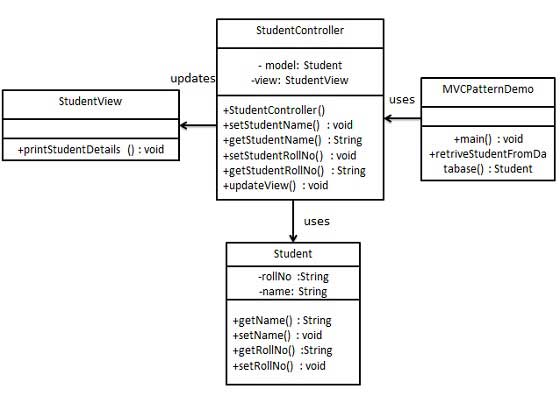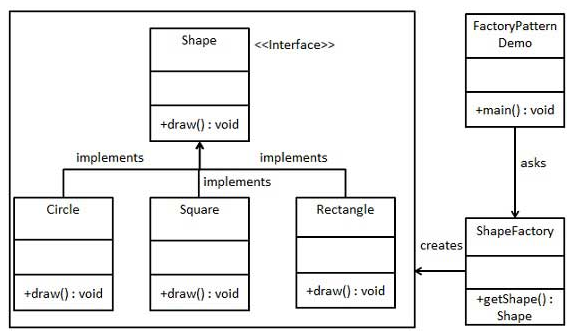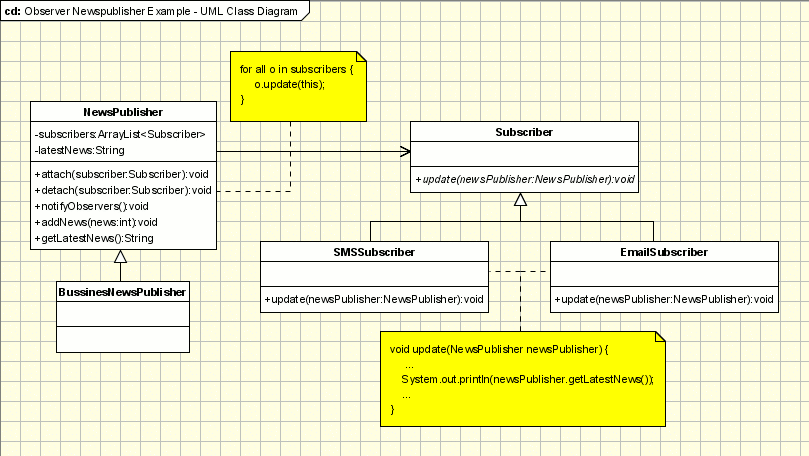Design Pattern - Basic
- Singleton Pattern
- MVC Pattern
- Tempalte Method Pattern
- Decorator Pattern
- Factory Pattern
- Observer Pattern
- [[proxy-pattern]]
Singleton Pattern
Eager: crate instance when the class is loaded
public class Singleton {
private Singleton() {}
private static final Singleton INSTANCE = new Singleton();
public static Singleton getInstance() {
return INSTANCE;
}
}
Lazy: crate instance only when its needed
public class SingletonDemo {
private SingletonDemo() {}
private static SingletonDemo instance = null;
public static synchronized SingletonDemo getInstance() {
if (instance == null) {
instance = new SingletonDemo();
}
return instance;
}
}
MVC Pattern
- Model: an object representing data or even activity
- View: some form of visualization of the state of the model
- Controller: offers facilities to change the state of the model

Template Method Pattern
It defines the program skeleton of an algorithm in a method, called template method, which defers some steps to subclasses.
public class Coffee {
public final void cookCoffee() {
stepA();
stepB();
stepC();
}
public abstract void stepA();
public abstract void stepB();
public abstract void stepC();
}
public class CabuchinoCoffee extends Coffee() {
public void stepA() {...}
public void stepB() {...}
public void stepC() {...}
}
实际用法实例:在父类中把”非功能性”代码写好,留下一个”口子”让子类去实现,子类只需要关注业务逻辑即可。
public abstract class BaseCommand {
public void execute() {
Logger logger = Logger.getLog(...);
logger.debug(...);
Utils.startTimer(...);
beginTxn();
doBusiness(); // need to override
commitTxn();
Utils.endTimer(...);
logger.debug(...);
}
}
class PlaceOrderCommand extends BaseCommand {
public void doBusiness() {
// implementation
}
}
class PaymentCommand extends BaseCommand {
public void doBusiness() {
// implementation
}
}
– 参考:《码农翻身》第二章/Spring的本质/设计模式:模板方法
Decorator Pattern
“在不必改变原类文件和使用继承的情况下,动态地扩展一个对象的功能。它是通过创建一个包装对象,也就是装饰来包裹真实的对象。” – 百度百科

- ConcreteComponent:需要扩展的类
- Component:需要扩展功能的接口
- Decorator:装饰类
- ConcreteDecorator:装饰类的实现
在以下示例中,为了扩展ConcretComponent的doSomething功能,比如在其调用前后做一些操作,我们创建了一个Decorator和ConcreteDecorator。
public class ConcretComponent implements Component {
public void doSomething() {
System.out.println("Do it!");
}
}
public interface Component {
public void doSomething();
}
public class Decorator implements Component {
public Component component;
public Decorator(Component component) {
this.component = component;
}
public void doSomething() {
this.component.doSomething();
}
}
public class ConcreteDecorator extends Decorator {
public ConcreteDecorator(Component component) {
super(component);
}
public void doSomething() {
System.out.println("Before Do it!");
this.component.doSomething();
System.out.println("After Do it!");
}
}
// Use
Component component = new ConcreteDecorator(new ConcretComponent());
component.doSomething();
// Print
Before Do it!
Do it!
After Do it!
- 装饰器模式(Decorator)——深入理解与实战应用
- 参考:《码农翻身》第二章/Spring的本质/设计模式:装饰者
Factory Pattern
- create object without exposing the creation logic to the client
- use a factory to create the object

public class ShapeFactory {
public Shape getShape(String shapeType) {
if (shapeType == null) {
return null;
}
if (shapeType.equalsIgnoreCase("CIRCLE")) {
return new Circle();
} else if (shapeType.equalsIgnoreCase("RECTANGLE")) {
return new Rectangle();
}
return null;
}
}
public class FactoryPatternDemo {
public static void main(String[] args) {
ShapeFactory shapeFactory = new ShapeFactory();
Shape shape1 = shapeFactory.getShape("CIRCLE");
shape1.draw();
}
}
Observer Pattern
- When to use: Whenever a subject has to be observed by one or more observers.
-
Intent: Defines a one-to-many dependency between objects so that when one object changes state, all its dependents are notified and updated automatically.
SubjectholdsStateandList of Observers.- When
Statechanges,Subjectwill notifyObserver. - And then
Observercan update the change to end user.

